Blank B.E., Krantz S.G. Calculus: Single Variable
Подождите немного. Документ загружается.


(In this calculation, notice that the expression |x| simplifies to x because x assumes
positive values as x- 1N.)
¥
INSIGHT
In each of Examples 11 and 12, the original difference leads to the
indeterminate form N2N. However, even though the two terms of the difference
individually have infinite limits, their difference results in a subtle cancellation that yields
a finite limit.
b A LOOK BACK We have encountered seven types of indeterminate forms. The
two basic indeterminate forms
0
0
and
N
N
can be handled directly with l’Ho
ˆ
pital’s
Rule. The indeterminate form 0 Nis generally converted to one of the basic forms
by placing the reciprocal of one of the factors in the denominator. That is, 0 N is
treated as
N
1=0
or
0
1=N
:
Some algebraic manipulation is necessary before l’Ho
ˆ
pital’s Rule can be applied to
the indeterminate form N2N. The three indeterminate forms that involve expo-
nents, namely 0
0
,1
N
, and N
0
, are converted to the indeterminate form 0 N by
applying the logarithm.
QUICK QUIZ
1. If lim
x-c
f ðxÞ5 lim
x-c
gðxÞ5 α, then what must α be to apply l’Ho
ˆ
pital’s Rule to
the limit lim
x-c
ðf ðxÞ=gðxÞÞ?
2. Evaluate lim
x-0
tanð3xÞ=tanð2x Þ.
3. For which indeterminate forms is it helpful to first apply the logarithm?
4. Evaluate lim
x-1N
ð
ffiffiffiffiffiffiffiffiffiffiffiffiffiffiffiffiffiffi
x
2
1 12x
p
2 xÞ:
Answers
1. α 5 0, α 52N,o
rα 51N 2. 3/2 3. 0
0
,1
N
, and N
0
4. 6
EXERCISES
Problems for Practice
c In each of Exercises 1216, use l’Ho
ˆ
pital’s Rule to find the
limit, if it exists. b
1. lim
x-0
ð1 2 e
x
Þ=x
2. lim
x-1N
lnðxÞ=
ffiffiffi
x
p
3. lim
x-5
lnðx=5Þ
x 2 5
4. lim
x-0
x 1 sinð5xÞ
x 2 3 sinð4xÞ
5. lim
x-π=2
lnðsinðxÞÞ
ðπ 2 2xÞ
2
6. lim
x-0
cosðxÞ2 1
e
x
2 1
7. lim
x-21
cosðx 1 1Þ2 1
x
3
1 x
2
2 x 2 1
8. lim
x-0
e
x
2 e
2x
x
9. lim
x-0
e
x
2 e
2x
x
2
10. lim
x-21
x 1 x
2
lnð2 1 xÞ
11. lim
x-1
lnðxÞ
x 2
ffiffiffi
x
p
12. lim
x-0
sin
2
ð3xÞ
1 2 cosð4xÞ
13. lim
x-1N
sinð3=xÞ
sinð9=xÞ
4.7 l’Ho
ˆ
pital’s Rule 345

14. lim
x-1N
sin
2
ð2=xÞ
3=x
15. lim
x-2N
ln ð1 1 1=xÞ
sinð1=xÞ
16. lim
x-π=2
tanð2xÞ=cot ðxÞ
c In each of Exercises 17224,
apply l’Ho
ˆ
pital’s Rule
repeatedly (when needed) to evaluate the given limit, if it
exists. b
17. lim
x-N
x
2
=e
3x
18. lim
x-N
x
3
=e
2x
19. lim
x-0
sin
2
ðxÞ
x
2
20. lim
x-1
ðx 2 1Þ
3
ln
2
ðxÞ
21. lim
x-1
ðx 2 1Þ
2
cos
2
ðπx=2Þ
22. lim
x-0
1 2 cosð4xÞ
sin
2
ðxÞ
23. lim
x-0
sinð2xÞ2 2x
x
3
24. lim
x-0
e
x
2 e
2x
2 2x
sinðx
3
Þ
c In each Exercises 25232,
use an algebraic manipulation to
put the limit in a form which can be treated using l’Ho
ˆ
pital’s
Rule; then evaluate the limit. b
25. lim
x-1N
x e
22x
26. lim
x-0
ðe
x
2 e
2x
Þx
21
27. lim
x-N
e
2x
lnðxÞ
28. lim
x-1N
x
22
lnðxÞ
29. lim
x-1
1
ðx 2 1Þ
21
lnðxÞ
30. lim
x-0
sinðxÞcotð3xÞ
31. lim
x-22
ðx 1 2Þtanðπx=4Þ
32. lim
x-π
tanðx=2Þ sinð3xÞ
c In each of Exercises 33240,
use the logarithm to reduce
the given limit to one that can be handled with l’Ho
ˆ
pital’s
Rule. b
33. lim
x-0
1
x
ffiffi
x
p
34. lim
x-0
1
ln
x
ðxÞ
35. lim
x-N
x 2 5
x
x
36. lim
x-1N
x lnðxÞ
21=x
37. lim
x-1N
x
1=x
38. lim
x-21
1
ð2 1 xÞ
lnðx11Þ
39. lim
x-1N
x
1=
ffiffi
x
p
40. lim
x-2N
ðx
2
Þ
ðe
x
Þ
c In each of Exercises 41246, put the fractions over a
common denominator and use l’Ho
ˆ
pital’s Rule to evaluate
the limit, if it exists. b
41. lim
x-N
x
3
ffiffiffiffiffiffiffiffiffiffiffiffiffi
x
2
1 5
p
2
x
3
ffiffiffiffiffiffiffiffiffiffiffiffiffi
x
2
1 3
p
42. lim
x-0
1
x
2
1
ln ðx 1 1Þ
43. lim
x-0
x
1 2 cosðxÞ
2
2
x
44. lim
x-0
1
3x
2
1
3 sinðxÞ
45. lim
x-0
1
sinðxÞ
2
1
sinð2xÞ
46. lim
x-0
1
e
x
1 e
2x
2 2
2
1
x
2
c In each of Exercises 47252,
use an algebraic manipulation
to reduce the limit to one that can be treated with l’Ho
ˆ
pital’s
Rule. b
47. lim
x-1N
ð
ffiffiffiffiffiffiffiffiffiffiffiffiffi
4x 2 5
p
2 2
ffiffiffi
x
p
Þ
48. lim
x-1N
ð
ffiffiffiffiffiffiffiffiffiffiffiffiffiffiffi
x
2
1 6x
p
2 xÞ
49. lim
x-2N
ðx 1 1Þln
x
x 1 1
50. lim
x-1N
ð
ffiffiffiffiffiffiffiffiffiffiffiffiffi
x
2
1 x
p
2
ffiffiffiffiffiffiffiffiffiffiffiffiffi
x
2
1 1
p
Þ
51. lim
x-1N
ð
ffiffiffiffiffiffiffiffiffiffiffiffiffiffiffiffi
e
2x
2 e
x
p
2 e
x
Þ
52. lim
x-1N
ffiffiffiffiffiffiffiffiffiffiffiffiffiffiffi
x
6
1 4x
p
2 ðx
3
1 1Þ
c In Exercises 53260,
calculate the given limit. b
53. lim
x-0
arctanðxÞ
x
54. lim
x-0
arcsinð3xÞ
arctanð2xÞ
55. lim
x-0
sinhðxÞ
expðxÞ2 1
56. lim
x-0
coshðxÞ2 1
sinhðxÞ
57. lim
x-0
cosh ðxÞ2 1
sinh
2
ðxÞ
58. lim
x-N
tanhð xÞ
arctanðxÞ
59. lim
x-0
arcsinðxÞ2 x
arctanðxÞ2 x
60. lim
x-0
arcsinh ðxÞ2 arcsinðxÞ
x
3
c In Exercises 61264, use the logarithm to reduce the
indeterminate form 1
N
to one that can be handled with
l’Ho
ˆ
pital’s Rule. b
61. lim
x-0
ðcos ð2xÞÞ
1=x
2
62. lim
x-N
ð
ffiffiffiffiffiffiffiffiffiffiffiffiffiffiffiffi
1 2 1=x
p
Þ
x
346 Chapter 4 Applications of the Derivative

63. lim
x-N
5 1 x
2 1 x
x
64. lim
x-0
11 sinðxÞ
cscðxÞ
Further Theory and Practice
65. Use l’Ho
ˆ
pital’s Rule to check that lim
h-0
1
ð1 1 hÞ
1=h
5 e:
Now calculate lim
h-0
1
ð1 1 hxÞ
1=h
for any fixed x.
66. Use l’Ho
ˆ
pital’s Rule to calculate
lim
h-0
f ðx 1 hÞ2 2f ðxÞ1 f ðx 2 hÞ
h
2
for a function f that is twice continuously differentiable at x.
67. Let a and b be constants with b 6¼1. Use l’Ho
ˆ
pital’s Rule
to calculate
lim
x-0
a sinðxÞ2 sinðaxÞ
tanðbxÞ2 b tanð xÞ
:
68. For any real number k and any positive number a prove
that
lim
x- 1N
x
k
e
ax
5 0:
c In each of Exercises 69276, use l’Ho
ˆ
pital’s
Rule to eval-
uate the one-sided limit. b
69. lim
x-ðπ=2Þ
2
ðx 2 π=2ÞcotðxÞ
70. lim
x-π
1
ðx 2 πÞtanðx=2Þ
71. lim
x-0
1
ln ð1 1 xÞ
ln ð1 1 3xÞ
72. lim
x-0
1
sinðxÞ
ln ð1 1 xÞ
73. lim
x-0
1
2lnðxÞ
ln ð2xÞ
74. lim
x-0
1
lnð1 1 xÞln ðxÞ
75. lim
x-0
1
x
21=ln ðxÞ
76. lim
x-0
1
x
5=ln ð2xÞ
c In each of Exercises 77282, a function f with domain either
I 5 (2N, N)orI 5 (0,N) is given. Sketch the graph of f. (The
set C of critical points of f and the set I of inflection points of
f are provided in some cases.) Use l’Ho
ˆ
pital’s Rule to deter-
mine the horizontal asymptote of the graph. If I 5 (0, N), use
l’Ho
ˆ
pital’s Rule to determine lim
x-0
1
f ðxÞ: b
77. f (x) 5 x/e
x
; I 5 (2N, N)
78. f (x) 5 x
2
/e
x
; I 5 (2N, N)
79. f (x) 5 e
x
/(e
x
1 x); I 5 (2N, N); I 5 {2.269 ...}
80. f (x) 5 ln (x)/x; I 5 (0, N)
81. f (x) 5 x ln (x)/(1 1 x
2
); I 5 (0, N); C 5 {0.301..., 3.319...};
I 5 {0.720..., 5.486...}
82. f (x) 5 ln (x)/(1/x 1 e
x21
); I 5 (0,N); C 5 {0.730 ...}; I 5
{1.646 . . . }
83. Suppose that r is a constant greater than 1. Let α be any
constant. Show that
lim
x-N
x
α
r
x
5 0:
Deduce that
lim
x-N
a r
x
1 pðxÞ
b r
x
1 qðxÞ
5
a
b
:
for any polynomials p (x) and q (x) and any constants a
and b with b 6¼0.
84. Evaluate
lim
x-N
x
ðx11Þ=x
ffiffiffiffiffiffiffiffiffiffiffiffiffi
1 1 x
2
p
:
85. For any constants α and β with β . 0, show that
lim
x-N
ln ðxÞ
α
x
β
5 0:
86. Cauchy’s Mean Value Theorem states the following: If
f (x) and g (x) are functions that are continuous on the
closed interval [a, b] and differentiable on the open
interval (a, b), then there is a point ξ 2 (a, b) such that
ðgðbÞgðaÞÞ f
0
ðξÞ¼ðf ðbÞf ðaÞÞ g
0
ðξÞ. Notice that, if
both g(a) 6¼g(b) and g
0
(ξ) 6¼0, then
f
0
ðξÞ
g
0
ðξÞ
5
f ðbÞ2 f ðaÞ
gðbÞ2 gðaÞ
:
Complete the following outline to obtain a proof of
Cauchy’s Mean Value Theorem
a. Let rðxÞ5
f ðbÞ2 f ðaÞ
gðxÞ2 gðaÞ
2
f ðxÞ2 f ðaÞ
gðbÞ2 f ðaÞ
:
Check that r (a) 5 r (b).
b. Apply Rolle’s Theorem to the function r on the interval
[a, b] to conclude that there is a point ξ 2(a, b)such
that r
0
(ξ) 5 0.
c. Rewrite the conclusion of (b) to obtain the conclusion
of Cauchy’s Mean Value Theorem.
87. Write the equation of the line through the points (g(a),
f (a)) and (g(b), f (b)). If P 5 (x, y) is a point in the plane
then calculate the vertical distance from P to this line.
Now give a geometric interpretation of the function r in
Exercise 86(a). Explain the motivation of the proof of
Cauchy’s Mean Value Theorem.
88. Use Cauchy’s Mean Value Theorem to prove the first
form of l’Ho
ˆ
pital’s Rule (Theorem 1).
Calculator/Computer Exercises
c In each of Exercises 89292, investigate the given limit
numerically and graphically. b
89. lim
x-0
ð1 2 cos ðxÞÞ=sin ðxÞ
2
90. lim
x-0
tanð2 sinðxÞÞ=sinð2 tanðxÞÞ
4.7 l’Ho
ˆ
pital’s Rule 347
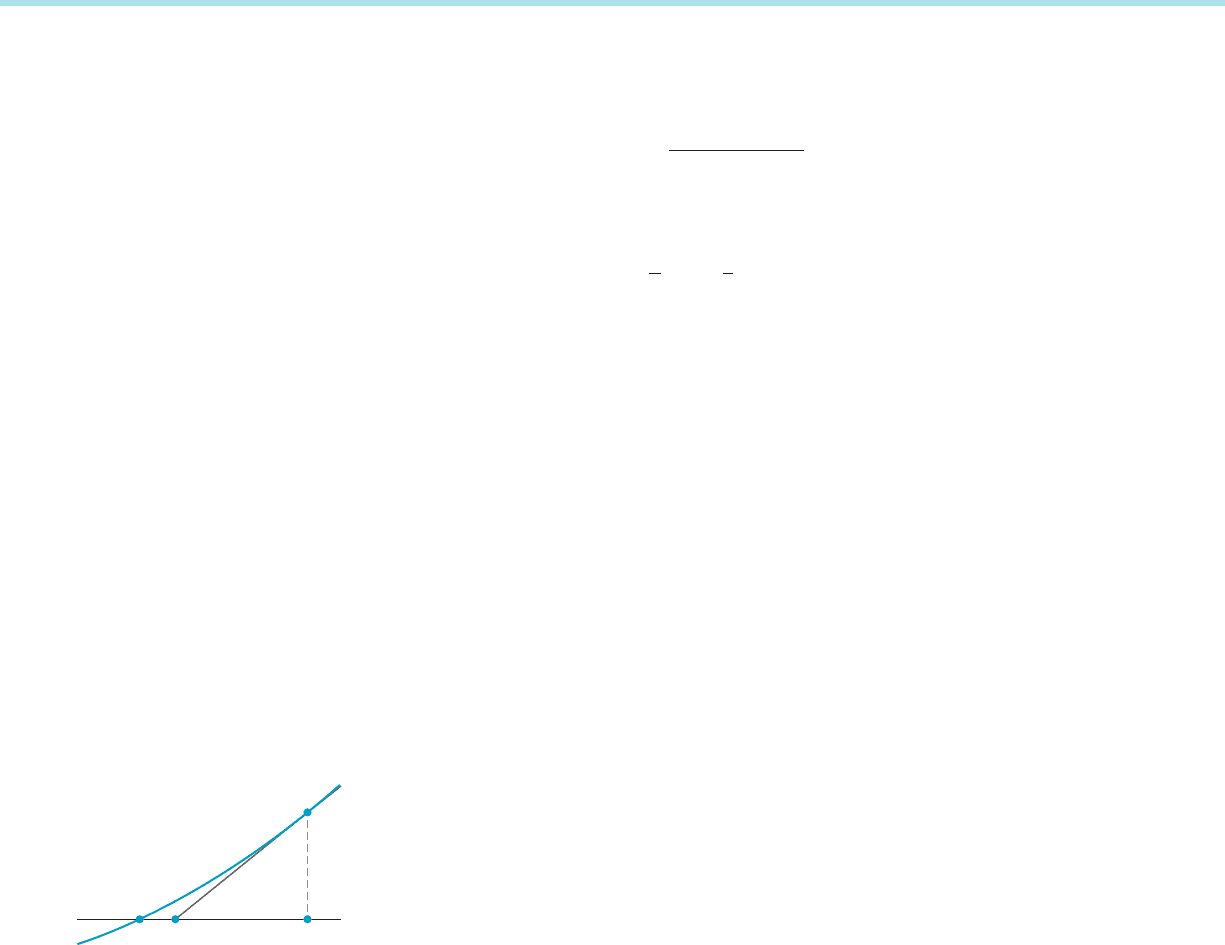
91. lim
x-0
1
x
ð12sinðxÞ=xÞ
92. lim
x-0
ð1 1 tanð2xÞÞ
1=x
c In each of Exercises 93295, illustrate the assertion of
l’Ho
ˆ
pital’s Rule by plotting f/g and f
0
/g
0
in an interval cen-
tered at c . b
93. f ðxÞ5 ð 1 2 cos ðxÞÞ; gðxÞ5 x tanðxÞ; c 5 0
94. f ðxÞ5 ð 1 1 x 2 e
x
Þ; gðxÞ5 x sinðxÞ; c 5 0
95. f ðxÞ5 ð1 1 cosðxÞÞ; gðxÞ5 ðx 2 πÞsin ðxÞ; c 5 π
96. Example 10 shows that lim
x-0
1
x
x
5 1. Plot y 5 x
x
for
values of x that have the form 2p/q where p and q are
positive integers with q odd. Let {x
n
} be a sequence of
such negative rational numbers with lim
n-N
x
n
5 0. What
can be said of lim
n-N
x
x
n
n
?
4.8 The Newton-Raphson Method
All quadratic equations ax
2
1 bx 1 c 5 0 can be solved explicitly by means of the
Quadratic Formula:
x 5
2b6
ffiffiffiffiffiffiffiffiffiffiffiffiffiffiffiffiffiffi
b
2
2 4ac
p
2a
:
There are formulas for solving cubic and fourth degree equations as well. However,
there are no elementary formulas for solving general polynomial equations of
degree five and higher . If we turn to transcendental equations, such as
π
3
5 x 2
1
2
sinðxÞ;
then matters are even more obscure. Yet there is often a need to solve such
equations, as we will see in several applied problems.
If we settle for an approximate solution of an e quation (with, say, a specified
number of decimal places of accuracy), then calculus enables us to find sufficiently
accurate solutions for many equations that come up in practice. The technique that
we will study in this section is called the Newton-Raphson Method (or sometimes
just Newton’s Method). It is one of the methods used by calculators and computer
algebra systems to solve equations.
The Geometry of the
Newton-Raphson
Method
See Figure 1 for the fundamental idea behind the Newton-Raphson Method: the
graph of a differentiable function f is approximated well, near a point (x
1
, f (x
1
)), by
the tangent line ‘ at the point (x
1
, f (x
1
)). The picture suggests that, if x
1
is near a
point c where the graph of f crosses the x-axis, then the point x
2
at which ‘ intersects
the axis will be even closer. This simple observation is the basic idea of the Newton-
Raphson Method.
⁄ EX
AMPLE 1 Let P denote the point at which the graphs of y 5 cos (x) and
y 5 x cross. A very rough estimate of the x-coordinate of P is π/3. Apply the
fundamental idea behind the Newton-Raphson method to find a better
approximation.
Solution T
he idea of the Newton-Raphson Method is to use a tangent line
approximation to improve an initial estimate of a root of an equation f (x) 5 0. We
start by casting the current problem into this form. The two curves intersect at
the value of x for which x 5 cos (x), or x 2 cos (x) 5 0. If we define f (x) 5 x 2 cos (x),
then the value c of x that we are seeking is the solution of f (x) 5 0. Let us begin
with the given estimate x
1
5 π/3 of c. The tangent line at (x
1
, f (x
1
)) that is, at
(π/3,π/3 2 1/2), has slope
cx
2
x
1
(x
1
, f(x
1
))
f
ᐉ
m Figure 1
348 Chapter
4 Applications of the Derivative
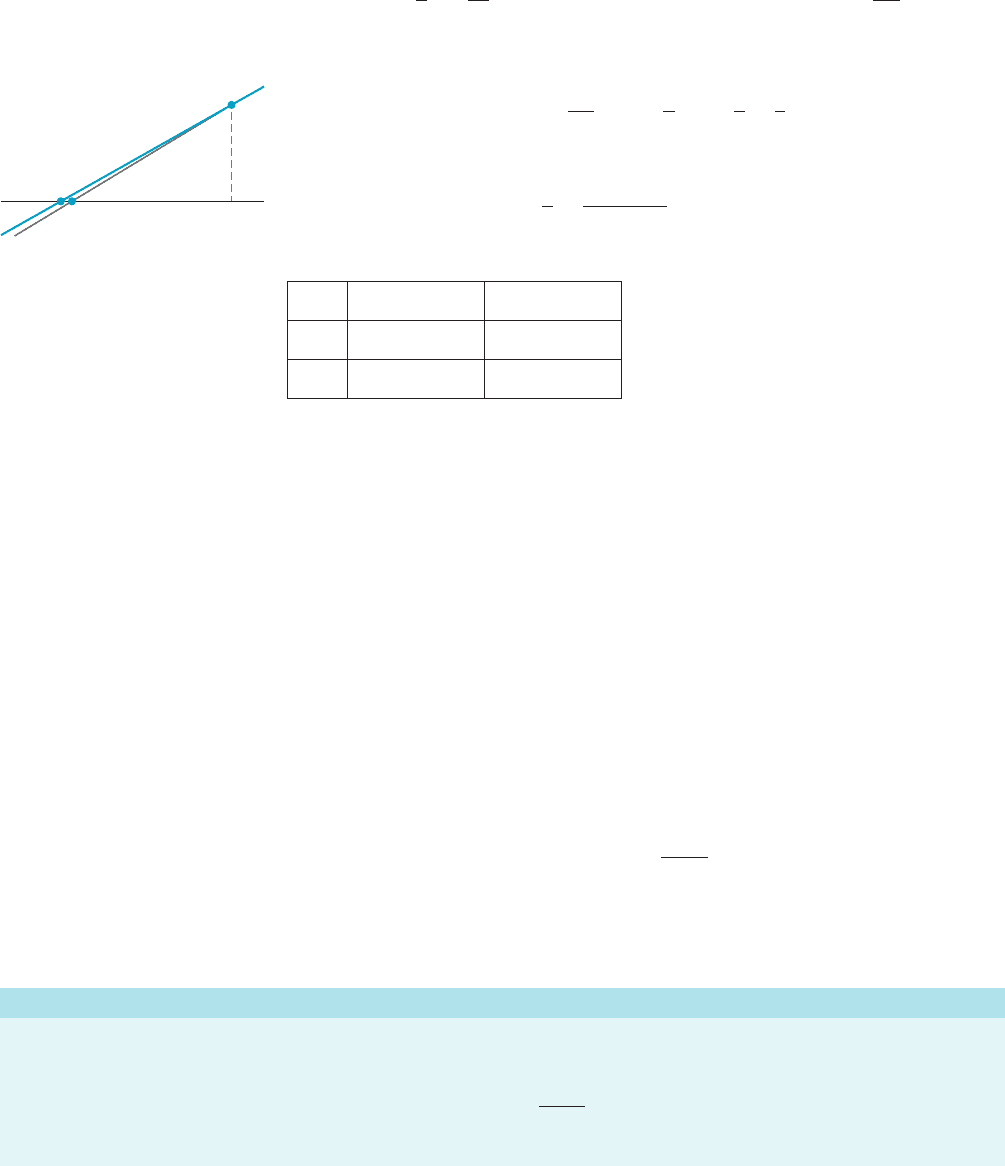
f
0
π
3
5
d
dx
x2cosðx
x5π=3
5
1 1 sinðx
x5π=3
5 1 1
ffiffiffi
3
p
2
:
The point-slope equation of the tangent line is therefore
y 5
1 1
ffiffiffi
3
p
2
x 2
π
3
1
π
3
2
1
2
:
The line intersects the x-axis when y 5 0—that is, at
x
2
5
π
3
1
1=2 2 π=3
1 1
ffiffiffi
3
p
=2
0:75395527:
See Figure 2. Now examine the table:
x cos (x)
x
1
1.0471976 0.5
x
2
0.75395527 0.72898709
We see that x
1
was a rather poor estimate: the values of x and cos (x) are quite
far apart for that value of x. However, applying the idea of the Newton-Raphson
Method results in a remarkable improvement: the values of x and cos (x) diff er by
less than 0.025 at x
2
. ¥
What if even greater accuracy is required? In that case, we can replace x
1
by x
2
and repeat the procedure to get a better approximation x
3
. We keep repeating until
the desired degree of accuracy is obtained. That procedure is the Newton-Raphson
Method.
Calculating with the
Newton-Raphson
Method
To put the Newton-Raphson Method to use, we need to develop an algorithm.Ifwe
are given a differentiable function f and an initial estimate x
1
of a root c of f,thenthe
tangent line at (x
1
, f (x
1
)) has point-slope equation
y 5 f
0
ðx
1
Þðx 2 x
1
Þ1 f ðx
1
Þ:
Let x
2
be the x-intercept of this tangent line. By substituting y 5 0andx 5 x
2
in the
equation of the tangent line, we find that
x
2
5 x
1
2
f ðx
1
Þ
f
0
ðx
1
Þ
; ð4:8:1Þ
provided that f
0
(x
1
) 6¼0. If we replace x
1
with x
2
on the right side of (4.8.1), then the
resulting expression is used to define the next approximation x
3
, and so on. Let us
summarize what we have learned.
The Newton-Raphs on Method
If f is a differentiable function, then the (n 1 1)
st
estimate x
n11
for a zero of f is obtained from the n
th
estimate
x
n
by the formula
x
n11
5 x
n
2
f ðx
n
Þ
f
0
ðx
n
Þ
;
provided that f
0
(x
n
) 6¼0.
x
2
0.75
f(x) x cos(x)
x
1
p3
m Figure 2
4.8 The Newton-Raphson Method 349

We can formulate the Newton-Raphson Method in a way that highlights its
iterative nature. Let
ΦðxÞ5 x 2
f ðxÞ
f
0
ðxÞ
: ð4:8:2Þ
Then, starting from a first estimate x
1
of a root c of f (x) 5 0, we generate sub-
sequent approximations, x
2
, x
3
, . . . by the formula
x
j11
5 Φðx
j
Þ: ð4:8:3Þ
⁄ EX
AMPLE 2 Use the Newton-Raphson Method to determine
ffiffiffi
3
p
to within
an accuracy of 10
27
.
Solution Th
e problem is equivalent to finding the positive value where the function
f (x) 5 x
2
2 3 vanishes. We first calculate f
0
(x) 5 2x and, following equation (4.8.2),
define
ΦðxÞ5 x 2
x
2
2 3
2x
5 x 2
x
2
1
3
2x
5
1
2
x 1
3
x
:
For a first estimate, we take x
1
5 1.7. Then, according to equation (4.8.3), we get
x
2
5 Φðx
1
Þ5
1
2
1:7 1
3
1:7
5 1:73235294:
A check with a calculator reveals that x
2
already agrees with
ffiffiffi
3
p
to three decimal
places of accuracy. Applying the Newton-Raphson Method a second time, we
obtain our third estimate
x
3
5 Φðx
2
Þ5
1
2
1:73235294 1
3
1:73235294
5 1:7320508:
This value agrees with
ffiffiffi
3
p
to seven decimal places of accuracy, as may be verified
with a calculator.
¥
Accuracy If we do not already know the answer in advance, or if we do not have a calculator
handy, how do we determine the accuracy of the approximation? If the Newton-
Raphson Method is to be useful in practice, then this is clearly a question that must
be answered.
Suppose that our sequence {x
n
} of Newton-Raphson estimates lies in an
interval on which the values of | f
0
(x)| are bounded by a constant C
1
. Suppose also
that x
n
and x
n 1 1
agree to k decimal places of accuracy. Then
x
n11
5 x
n
1 ε
where |ε| , 5 3 10
2(k 1 1)
. Thus
x
n
2
f ðx
n
Þ
f
0
ðx
n
Þ
5 x
n
1 ε;
or
f ðx
n
Þ52f
0
ðx
n
Þε:
350 Chapter 4 Applications of the Derivative
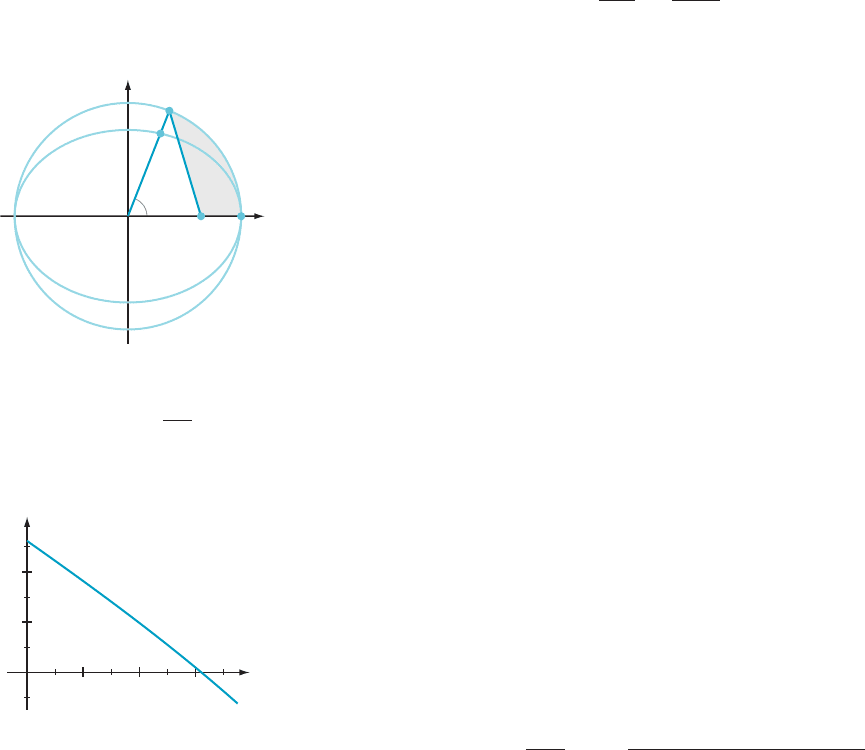
It follows that
jf ðx
n
Þj 5 jf
0
ðx
n
Þεj
5 jf
0
ðx
n
Þj jεj
# C
1
5 3 10
2ðk11Þ
5 5 C
1
10
2ðk11Þ
:
This inequality allows us to estimate how close f (x
n
) is to zero. In practice we may
just continue the iterations until two or three successive approximations are within
5 3 10
2 (k 1 1)
of each other. This is usu ally the signal that any further refinement
will take place beyond the k
th
decimal place.
If f has a continuous second derivative, then we can say more about the rate at
which the Newton-Raphson iterates {x
n
} approach a root c of f. Let us denote the
absolute difference |c 2 x
n
|byε
n
.Iff
0
(c)andf
00
(c) are nonzero, and if the Newton-
Raphson iterations {x
n
} converge to c, then it may be shown that
lim
j-N
ε
n11
ε
2
n
5
f
00
ðcÞ
2f
0
ðcÞ
: ð4:8:4Þ
We will use this result only to explain why the Newton-Raphson Method often yields
a very accurate approximation after only a few iterations. To that end, notice that the
right side of equation (4.8.4) is just a positive number—let us call it C. Equation
(4.8.4) says that ε
n11
C ε
2
n
for large n. Thus when the Newton-Raphson Method is
successful, the (n 1 1)
st
error ε
n11
is approximately proportional to the square ε
2
n
of
the n
th
error. For example, if ε
n
is on the order of 10
23
,thenε
n11
will be on the order
of 10
26
and ε
n12
will be on the order of 10
212
. A loose rule of thumb is that, in a
successful application of the Newton-Raphson Method, the number of decimal
places of accuracy doubles with each iteration. The technical description is that the
Newton-Raphson Method is a second order process.
⁄ EX
AMPLE 3 Kepler’s equation
M 5 x 2 e sin (x)
relates the mean anomaly M and the eccentric anomaly x of a planet travelling
in an elliptic path of eccentricity e. See Figure 3. It is important in predictive
astronomy to be able to solve for x if M is given. Kepler expressed his opinion
that an exact solution for x is impossible: “ . . . if anyone would point out my mis-
take and show me the way, then he would be a g reat Apollonius in my opinion.”
Instead of finding an exact solution, find x to four decimal places when M 5 1.0472
and e 5 0.2056 (the eccentricity of Mercury’s orbit).
Solution Let f (x) 5 1.0472 2 x 1 0.2056 sin
(x). Because f (0) 5 1.0472 . 0 and
f (π/2) 520.3180 , 0, the Intermediate Value Theorem tells us that f has a root c
in the interval (0, π/2). We calculate f
0
(x) 521 1 0.2056 cos (x). Because f
0
(x) ,2
1 1 0.2056 1 , 0, we can deduce that f is decreasing and the equation f (x) 5 0 has
only one solution. The graph of f in Figure 4 confirms our analysis. From the graph,
it appears that x
1
5 1.2 is a good first estimate. We let
ΦðxÞ5 x 2
f ðxÞ
f
0
ðxÞ
5 x 2
1:0472 2 x 1 0:2056 sin ðxÞ
2 1 1 0:2056 cosðxÞ
x
y
0.8 1.20.4
0.4
0.8
f
(
x
)
1.0472 x 0.2056ⴢ sin
(
x
)
m Figure 4
y
x
F
(Sun)
A
O
P
Q
x
m Figure 3
When a planet is at position P,
its
mean anomaly M is defined by
M 5 2ðAreaðAFQÞ=
OA
2
Þ.
4.8 The Newton-Raphson Method 351
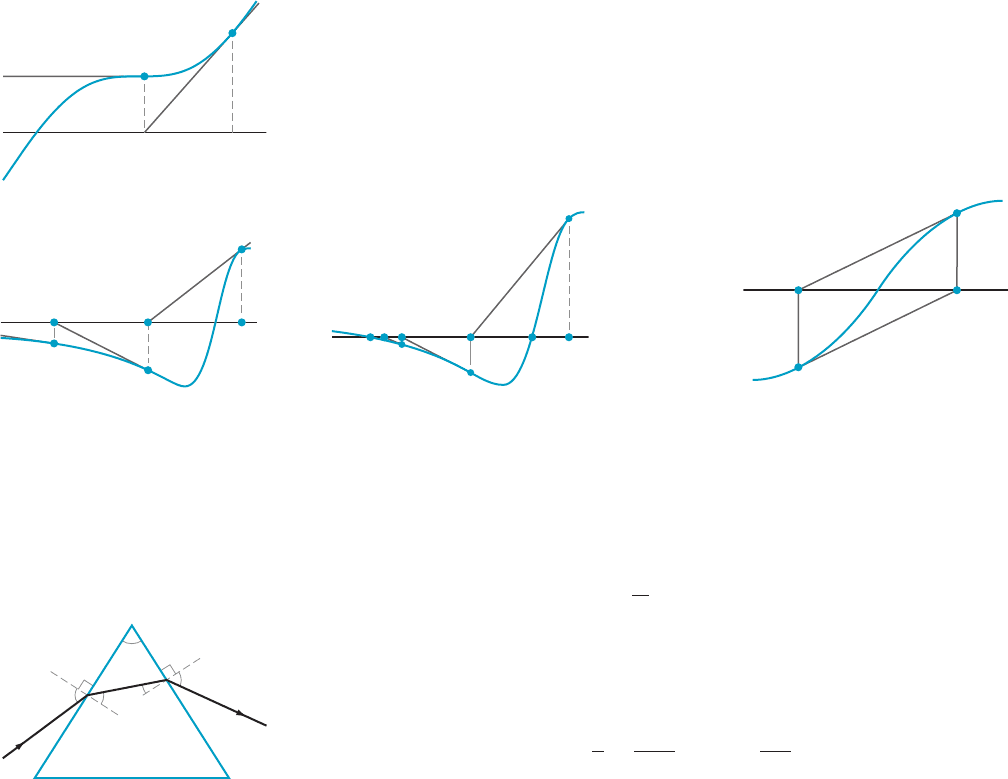
and calculate
x
2
5 Φðx
1
Þ5 1:2419527
x
3
5 Φðx
2
Þ5 1:2417712
x
4
5 Φðx
3
Þ5 1:2417712:
Because |x
4
2 x
3
| , 5 3 10
25
, we can be reasonably sure that c 5 1.24177 is correct
to four decimal places.
¥
Pitfalls of the Newton-
Raphson Method
Obviously the Newton-Raphson Method will go badly wrong if f
0
(x
j
) 5 0 for some
index j. Look at Figure 5. We see that the tangent line at x
j
is horizontal, so of
course it never intersects the x-axis, and the method breaks down. In fact, there can
be trouble if f
0
(x
j
) is small, even if it is not zero, because f (x
j
)/f
0
(x
j
) can be large. If
this is the case, then x
j 1 1
will be far from x
j
even thou gh the root may be close to x
j
,
as is illustrated in Figure 6. In these circumstances, we say that the Newton-
Raphson Method diverges. The overshoot that causes this divergence can result in
convergence to a root other than the one that is sought (Figure 7). If an inflection
point is located close to a root, then the phenomenon of cycling may occur (see
Figure 8). The best thing to do when presented with one of these problems is to try
a different initial estimate.
A Computer
Implementation
The Newton-Raphson Method can be easily implem ented on a calculator or
computer. The next example shows how to put the method into action using
the computer algebra system Maple.
⁄ EX
AMPLE 4 The index of refraction r of a triangular glass prism satisfies
r sin
α 2
θ
1
r
5 sinðθ
4
Þ;
where the angles α , θ
1
, and θ
4
are as in Figure 9. If α, θ
1
, and θ
4
are measured to be
45
,46
, and 54
respectively, then what is r to eight decimal places?
Solution Let
f ðrÞ5 r sin
π
4
2
46 π
180 r
2 sin
54π
180
:
As in most computations that involve the derivatives of trigonometric functions, we
con
vert to radian measurement of angles. Figure 10 then shows a solution using
Maple. Because |x
5
2 x
4
| , 5 3 10
29
, we can be reasonably cert ain that
r 5 2.08020645 is correct to 8 decimal places. (However, if α, θ
1
, and θ
4
have not
C
x
j
f(x
j
) 0
x
j–1
m Figure 5
x
j
x
j1
C
m Figure 8
u
1
u
2
u
3
u
4
a
m Figure 9 Refraction of light
by a triangular prism
C
x
j
x
j1
x
j1
m Figure 6
C
x
j
x
j1
x
j1
C
˜
m Figure 7
352 Chapter
4 Applications of the Derivative
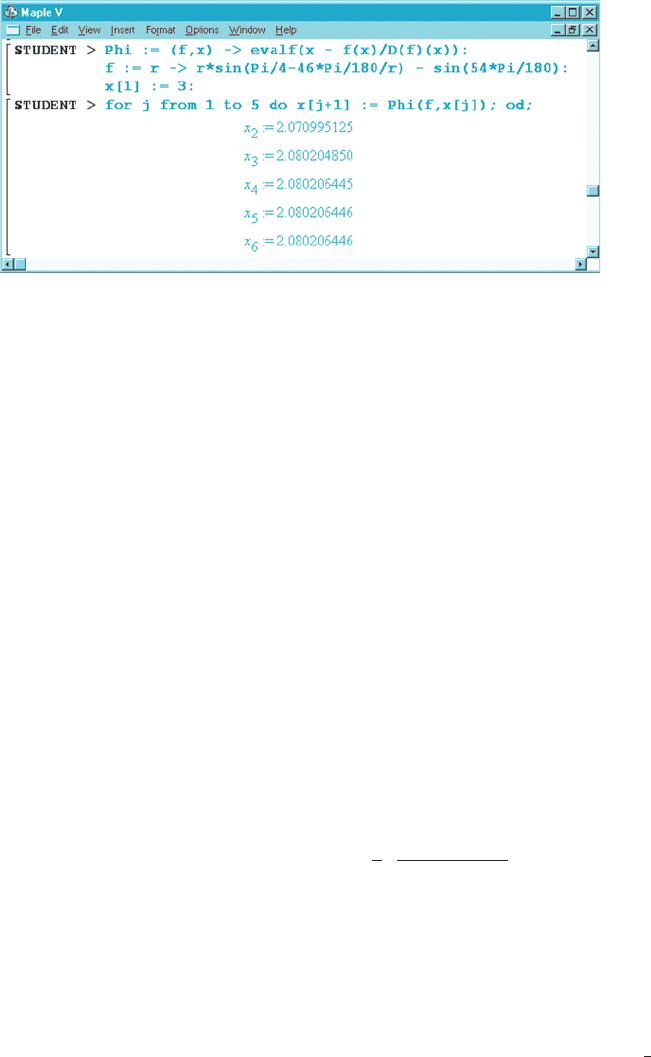
been measured to more than 2 significant digits, then the extra digits in our answer
have no reliability.)
¥
An Application in
Economics: Bond
Valuation
When a corporation or government issues a bond and sells it to an investor, the
issuer agrees to pay back (or redeem) the face value P to the investor in a specified
number n of years (at which time the bond is said to mature). If the coupon rate of
the bond is 100r% then, until the bond matures the issuer makes semi-a nnual
interest payments amounting to rP/2 each. For example, a bond with a $5000 face
value that pays $125 in interest every six months is said to have a 5% coupon rate
because r 5000/2 5 125 implies that r 5 0.05. After a bond has been issued, the
redemption value P and the coupon rate r do not change.
Because bondholders often want to sell bonds before their maturity, deter-
mining the market value of a bond is an important problem. The market price V of
a bond is rarely its face value P. As interest rates vary, the market price V of a bond
must adjust accordingly. For example, if interest rates have gone up because B was
issued, new bonds will have a higher coupon rate than B. The only way to sell bond
B is to offer it at a price V that is below its face value P.
An investor who redeems a bond will enjoy a capital gain (or suffer a capital
loss) if he has purchased the bond at a market price V that is less than (or greater
than) its redemption price P. This capital gain or loss must be considered in the
determination of the effective yield x of the bond. The effective yield x is expressed
by the formula
V 5 P
ð1 1 xÞ
2n
1
r
2
1 2 ð1 1 xÞ
2n
ffiffiffiffiffiffiffiffiffiffiffi
1 1 x
p
2 1
:
In practice, the investor will know the price V at which a bond is offered as well as
its coupon rate r, its face value P, and its maturity n. To make an informed decision,
the investor must determine the effective yield x. Because it is not feasible to solve
exactly for x, a root approximation method such as the Newton-Raphson Method is
necessary.
⁄ EX
AMPLE 5 A bond with a face value $10000, coupon rate 6
3
4
%; and
maturity of 20 years sells for $9125. What is the effective yield of the bond? (Bond
yields are customarily stated with two decimal places of accuracy.)
m Figure 1 0
4.8 The Newton-Raphson Method 353
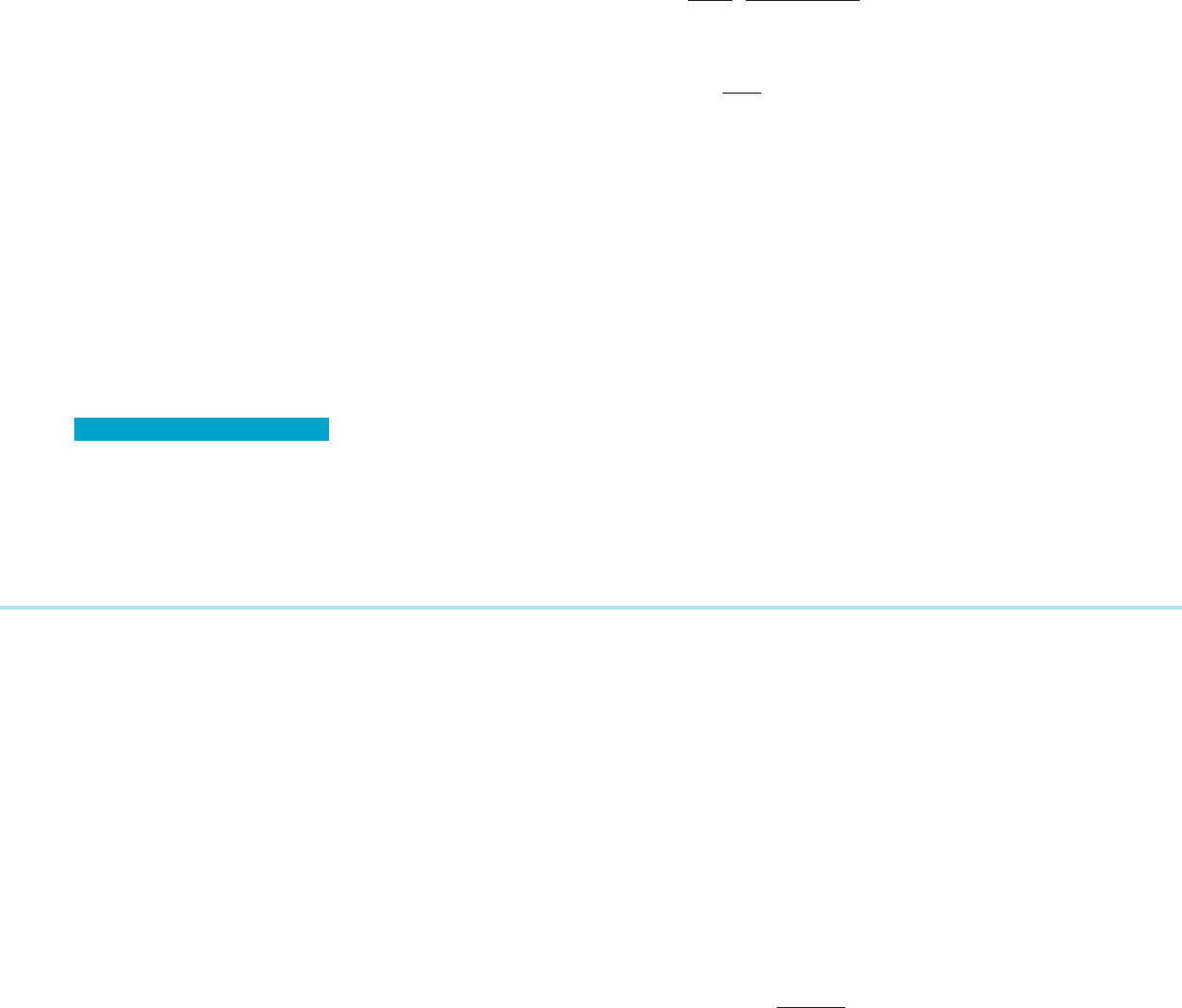
Solution Here, P 5 10000, r 5 0.0675, n 5 20, and V 5 9125. Let
f ðxÞ5 10
000
ð1 1 xÞ
220
1
:0675
2
1 2 ð1 1 xÞ
220
ffiffiffiffiffiffiffiffiffiffiffiffiffiffiffiffiffiffiffi
1 1 x 2 1
p
2 9125
and
Φ ðxÞ5 x 2
f ðxÞ
f
0
ðxÞ
:
Because there is a capital gain, the effective yield is greater than r. It therefore
makes sense to start our approximation process with a number x
1
greater than r.If
we choose x
1
5 0.07, then we calculate that
x
2
5 Φð0:07Þ5 0:07711
x
3
5 Φð0:07711Þ5 0:07753
x
4
5 Φð0:07753Þ5 0:07753:
(Clearly, f is quite complicated and Φ is even more so. The recorded values of Φ(x
n
)
have been obtained by using a computer algebra system.) The agreement between
x
3
and x
4
to two decimal places indicates that it is time to stop the algorithm. The
effective yield x is 7.75.%
¥
QUICK QUIZ
1. If we wish to apply the Newton-Raphson Method to calculate 4
1/5
by setting
x
1
5 1 and letting x
n 1 1
5 Φ(x
n
) for n $ 1, then what function Φ can we use?
2. If we use the Newton-Raphson Method to find a root of f (x) 5 x
5
1 2x 2 40 and
x 5 2 is our first estimate of the root, then what is our second?
Answers
1. x 2 (x
5
2 4)/(5x
4
) 2. 84/41
EXERCISES
Problems for Practice
c In each of Exercises 126, use formulas (4.8.2) and (4.8.3)
together with the given initial estimate x
1
to find the next two
estimates, x
2
and x
3
, of a root of the given function f. In each
case, x
3
will be accurate to at least two decimal places. b
1. f (x) 5 x
2
2 6, x
1
5 2
2. f (x) 5 x
3
1 2, x
1
521
3. f (x) 5 x
2
2 5x 1 2, x
1
5 4
4. f (x) 5 x
3
1 x 1 1, x
1
521
5. f (x) 5 x
5
2 24, x
1
5 2
6. f (x) 5 x
4
2 70, x
1
5 3
c In each of Exercises 7212,
a number is specified in the form
a
b
. Use formulas (4.8.2) and (4.8.3), the given initial estimate x
1
,
and a function f (x) 5 x
p
2 a
q
with p and q positive integers to
find the next two estimates, x
2
and x
3
, of the given number. b
7. 4
1/3
, x
1
5 2
8. (25)
1/3
, x
1
522
9. 6
1/2
, x
1
5 2.5
10. (0.5)
3/2
, x
1
5 0.5
11.
ffiffiffiffiffi
10
p
, x
1
5 2
12. (27)
3/5
, x
1
523
Further Theory and Practice
13. If f is a nonconstant linear function, how many iterations
of the Newton-Raphson Method are required before the
root of f is found? Does your answer depend on the initial
estimate?
14. Suppose you are applying the Newton-Raphson Method
to a function f and that after five iterations you land
precisely on a zero of f. What value will the sixth and
subsequent iterations have?
15. Suppose that a given function f satisfies f (c) 5 0 and that,
in addition, there is an interval I about c such that
f ðxÞf
00
ðxÞ
f
0
ðxÞ
2
, 1:
Then it is known that if the initial estimate is a point chosen
from the interval I then the Newton-Raphson Method will
354 Chapter 4 Applications of the Derivative
